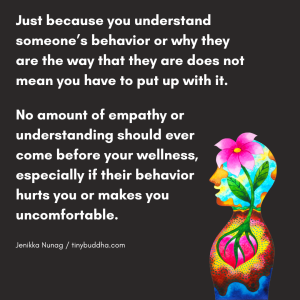
“As long as you make an identity for yourself out of pain, you cannot be free of it.” ~Eckhart Tolle
I remember it like it was yesterday—sitting in the corner of a bar in Holland at a social gathering, feeling alienated because I didn’t know the people I had to mingle with. After all, they were friends of my girlfriend at the time.
My worries had consumed me and I didn’t know where to begin. I wondered: Should I pluck up the courage to strike up a conversation, or should I withdraw?
I realized from this experience that I lacked self-confidence.
I was bullied as a kid, and because of my inability to connect with my peers I spent a lot of time in my room playing video games. I had no idea how to communicate, let alone show people who I really was as a person and what I had to offer.
In the long-term, my relationships suffered, I did terrible at job interviews, and I was always misunderstood, all things that affected my self-confidence.
I knew by my early twenties that something had to change. It seemed that everyone in my age group lived normal lives, with a great circle of friends—something that I always dreamed of having, but avoided with video games and social networking.
I understood that I had to start doing things differently; that I should no longer refuse an invite from a friend to go out and meet new people. That I should no longer say no to potential meetings, and to at least give things a try to see what happens.
My New Discovery
I realized that the potential for interacting with people was all around me. I vividly remembered going to department stores with my family, seeing people who I really wanted to meet, and resisting only to regret it later.
I knew at that moment that this was the biggest hurdle I had to deal with. If I were to simply get over my fears, my social skills and sense of self-confidence would begin to improve.
I understood at that moment that while I had a fear of approaching and starting conversations with strangers, I could get past it.
Slowly but surely, I did. I started taking baby steps by asking for directions and creating small talk with coffee shop baristas.
After doing this repeatedly, I eventually found myself in a place where I could easily strike up conversations and be comfortable in new environments. Sure, I still had a long way to go in being completely natural, but I knew I was making progress.
Fast-forward to today, my life has transformed. I no longer see people as strangers to fear; instead, I see opportunities to add value and make new friends.
What I Learned
The path I took was clear, and I will explain it to you as follows:
1. Be willing to fail and get rejected.
One of the first things I had to deal with when getting over my fears with strangers was the idea of getting rejected.
I would always imagine the worst possible scenario of getting told to go away, and this would prevent me from talking to them. This fear faded after I got rejected a handful of times.
I eventually understood that there was nothing to be afraid of since many of the people I’d met were indeed strangers who didn’t know me.
Understand that rejection is part of the process and that it’s never personal. There are a multitude of reasons why some people may not be willing to talk, and often it has nothing to do with you.
There is no way to know unless you go over and find out!
2. Find genuine reasons to talk to people.
What worried me the most was that I wouldn’t know what to say to people. What can you say to someone when you don’t know who they are?
I was left with only one choice: to somehow come up with a genuinely good reason to talk to them in the first place. Maybe it was it their style. Or I was lost and looking for directions. Or I was curious about where they were from.
Whatever the reason, start to become observant and really think about what it is about that person you would like to find out about.
3. Create a balance between statements and questions.
Try to imagine how you talk to good friends. How does the conversation usually flow?
One of the best ways to make a person feel comfortable is to balance statements and questions. Share about yourself and ask about them. Use their responses to your questions to shift the conversation toward topics they’re most comfortable with.
4. Be positive and playful.
As I started approaching more people and improving my communication skills, I began to see patterns in what people found comforting and what they found awkward. It was clear that most people prefer talking about uplifting topics, since most of us deal with a lot of negativity in our daily lives.
The more I appeared warm, friendly, and playful, the more value I was providing to people. I became a beacon of positivity, which emanated out of me, and in turn, allowed others to feel the same.
5. Be genuinely interested in people.
When you take an interest in other people’s lives, it makes them see that you’re genuinely interested in who they are.
What is it about them that you’re curious about? What of what you’ve already learned do you appreciate? Asking them about these things allow you to learn more about what makes them tick.
6. Remember how happy you feel when you connect with others.
The more I socialized, the more I started to feel a sense of happiness in myself and with others. I felt connected with society, and knew that the only way I could ever get to this place was through taking personal responsibility and getting out of my own way.
While I can’t promise the same results as I had when taking these actions, what I can promise you is an increased sense of joy and connection with the outside world. We all want a sense of belonging. And once you find it, your sense of self-confidence will begin to flourish.
Photo by Austin Goldberg
About Onder Hassan
Onder Hassan is passionate about building Self-Confidence and has started a Self-Confidence blog to help others do the same. He is also a published author of How To Cure Social Anxiety: An Alternative Guide. Sign up for his FREE YOU 2.0 course for a simple strategy to overcoming your fears to take you to the next level. He can be found on Google+













 Though I run this site, it is not mine. It's ours. It's not about me. It's about us. Your stories and your wisdom are just as meaningful as mine.
Though I run this site, it is not mine. It's ours. It's not about me. It's about us. Your stories and your wisdom are just as meaningful as mine. 